The best products start from real problems: Intercom about Jobs-to-be-Done. Part 2

The second part of the translation of the Intercom book about Jobs-to-be-Done is a continuation of the story about how the concept of Jobs-to-be-Done changes the principles of creating and improving an IT product. Chapters three through six.
First part
Chapter 3. More Than Mattresses: A Study of Jobs-to-be-Done Software Users
Posted by: Emma Meehan
When I started working as a product researcher at Intercom, I was quite skeptical about Jobs-to-be-Done. And she asked herself: “Can't we find customers' problems with classical methods of studying users?” How much I was mistaken. The concept gave me the tools to understand what motivates the customer to purchase our product and what disappoints when using it. Other techniques for studying users cannot offer this.
If you are new to Jobs-to-be-Done, you probably asked a question like this: “What would change in a case with mattresses when buying software?” This chapter will give you some practical tips and fundamental concepts about Jobs-to-be -Done for your software development business.
***
A lot of material has been written to learn about Jobs-to-be-Done interviewing techniques, but most of them focus on physical products. For example, you could read about why people buy mattresses . However, if you work in a software company, then legally ask what place this concerns me.
The interview techniques described here describe how to focus on emotional triggers at specific points in a conversation that can lead to “hiring” or “firing” a product.
After conducting many interviews, we realized that the fundamental techniques for interviewing Jobs-to-be-Done can be applied, adapting them to the needs of software product design.
We will tell you how we did it.
First thought extraction
The first thing you notice in a Jobs-to-be-Done interview is the emphasis on “extracting the first thought” from a purchase decision or switching to another product. For a physical product, it’s simple: you can deeply immerse yourself in the character of the client’s thinking and the surrounding environment at the time of purchase.
- When did you start looking at another mattress?
- Where were you making your decision?
- Who were you with at that time?
In the case of software, it can be difficult to pull out the “first thought”. Question: “Was it raining on the day of registration in the Calendar?” - it’s unlikely to refresh someone’s memory. We realized that the first thought can be multidimensional.
Take corporate software. The reason for switching to a new product is influenced by many factors, from the lack of a budget and changes in the management team to the simultaneous use of several tools to perform the same work.
These factors can be added to your interviews. Use the functional features of the company along with emotional triggers.
- What tool was used before purchase <software name>? How did you participate in the purchase?
- What was it like working in <department name> <company name>?
- Do you remember who else made the decision? What roles did they play?
- Tell us about <previous decision>. How well did it work? Was it used only in your department?
Four forces
ReWired Group has identified four forces that repel and attract to buy. In our "mattress" scenario there are the following:
- Rejection: "This mattress is so uncomfortable that I woke up several times a night with back pain."
- Retraction into a new solution: "If I take a new mattress, I can get enough sleep, therefore I will feel better at home and at work."
- Anxiety: “What if the new mattress is no better than the old? I can only try it for a couple of minutes at the store. ”
- Attachment to the current solution: "I slept on this mattress when I was still at college."
The decision to purchase software can be determined by both business goals, such as increasing involvement or revenue, and personal goals, for example, increasing the level of happiness. However, well-designed software satisfies all needs. You can bet that previous purchases may have a greater influence on the decision to purchase software than the attractiveness of the instrument in question. In the case of software, four forces act as follows:
- Rejection: “We get a conversion lower than necessary. We cannot afford to pay so much. ”
- Pulling into a new solution: “If we switch to a new tool with a larger set of functions to increase conversion, we can achieve our goals.”
- Anxiety: “What if the new tool cannot be integrated, as it should? Earlier we tried three tools, but not one came up. ”
- Attachment to the current solution: "We have set up work processes and integration, so I would not want to do it again."
Creating a decision model
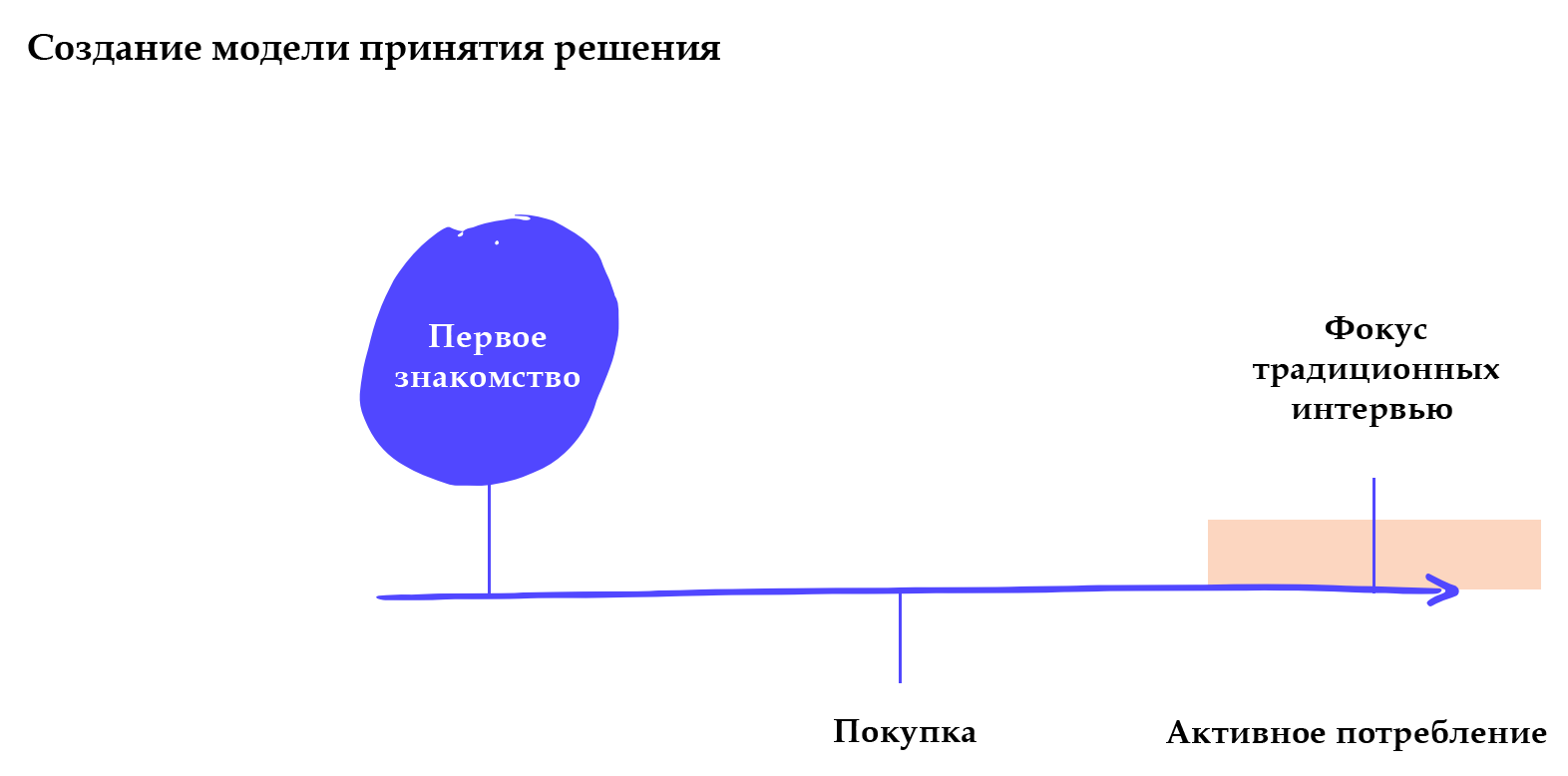
The decision-making model describes the time interval during which a person or company studies all the possible decisions that products can provide for the work. Active and passive searches can be distinguished. Active search usually begins after a disappointment in the product. Passive search can take weeks or months - until the user is sure that the product is completely suitable for him.
In the case of software development, by asking questions based on the decision-making model, you can reveal situations where people have repeatedly made a purchase decision.
- When did you realize that you want to purchase a new solution? Have you thoroughly researched this issue before concluding that the solution is right for your company?
- When did you first hear about your chosen instrument?
- Can you recall how you came to purchase this particular tool?
- Did you try other tools while searching? If so, which ones?
- How long could you not decide to click the buy button on the product website?
Timeline
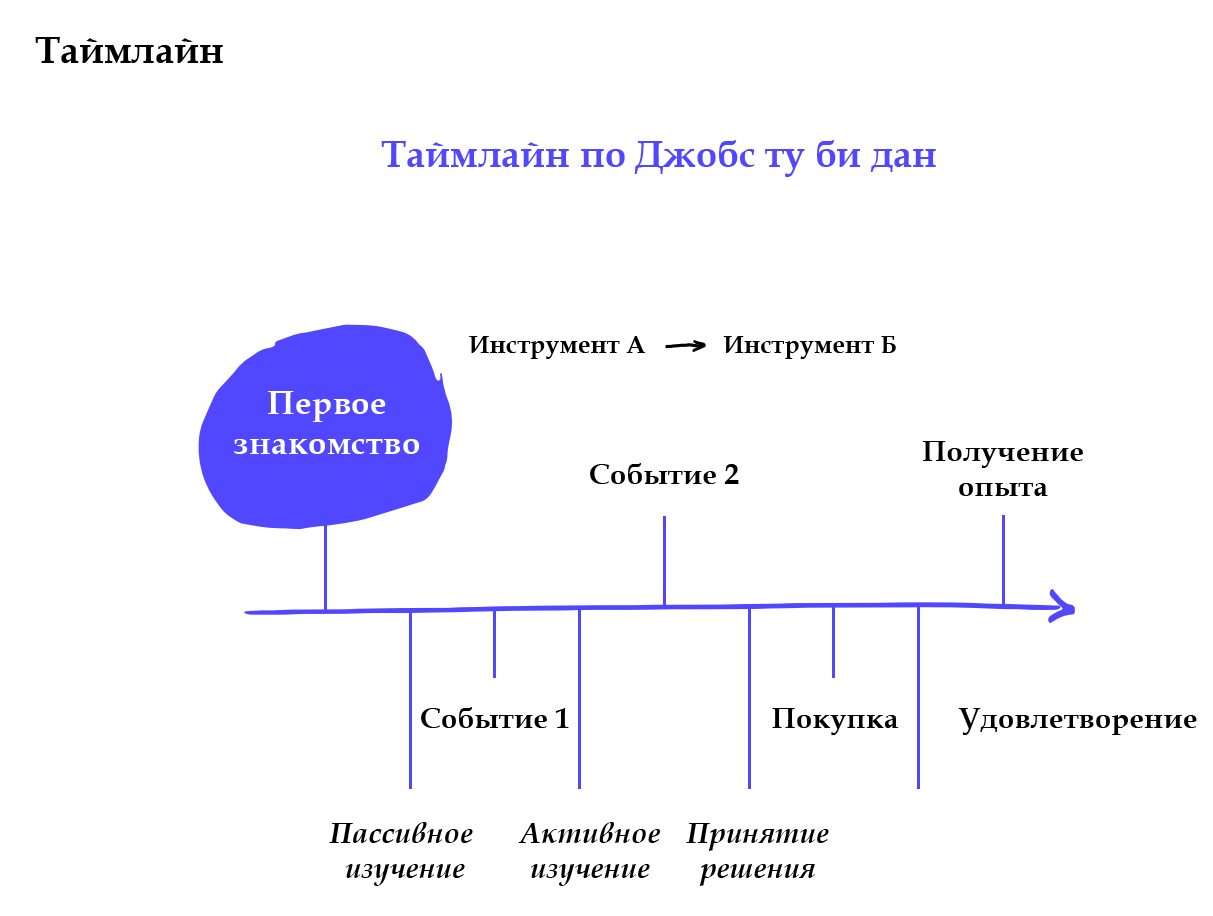
Building a timeline of events helps guide the client through all stages of the purchase. We learned that in the case of software purchase, there are usually multiple timelines.
Earlier we conducted an interview to understand why companies are switching from tool A to tool B. A completed it with two timelines. The first timeline is why the company switched from tool A to tool B, the second - why they switched from B to G.
I repeat that many people participate in the decision to purchase software. But you need to find the one on whom most of the decision depends. You can often hear: “I did not work for the company when I bought the software, but I use this solution the most!”
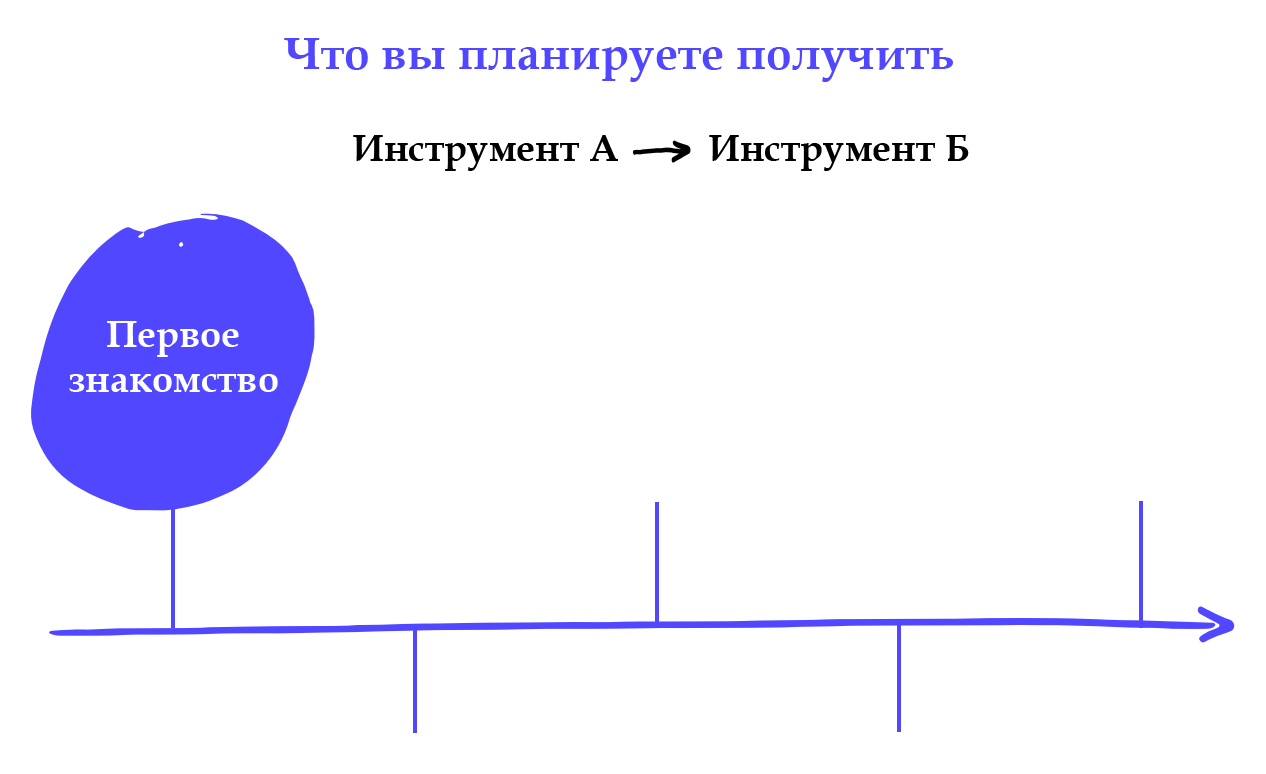
“I did not work for the company when they switched to tool A.”

It's like interviewing a parent who has bought a mattress for their child. It is useful to talk with the child so that he tells you how good the mattress is, but in fact you want to find out from his parent why he bought the mattress in this store.
If we talk about buying software, then the main figure in decision-making can be revealed by asking the following questions:
- What did you do to ensure that the company switched to this product? What impact did you have?
- Who made the transition decision? Are these people still working for the company? What are their roles?
The knowledge of all the actors who made the decision creates a more complete picture for understanding where and what changes should be made and how to sharpen the product for the work for which the decision is chosen.
More than mattresses
Jobs-to-be-Done can be a great tool to help you understand why companies are “hiring” and “firing” a product, as well as identifying areas for innovation. But remember: what is suitable for physical products cannot be used directly for software. Software purchase is multidimensional; several purchasers with different terms of decision-making are involved in it. Adapting interview techniques to your needs, you will get a framework suitable for any modern software company.
Chapter 4. Switch Clients
Posted by: Des Traynor
Most purchases are made out of habit without a careful study of alternatives. For example, people order the same coffee drink at the same coffee shop every morning, because the cost of changing a habit is high. People rarely switch, but when they do, there is an interesting set of driving forces behind this decision. Whether it’s coffee or software, the business chooses the simplest path and simply tries to make their product look more attractive than anyone else. The appearance of the product is just one component of all that prompts switching.
Speaking of switching, we are talking about combating fear or doubt before trying your product, as well as existing problems of the current solution. There are pretty good reasons why people still want to use Microsoft Word, no matter how good your text editor is.
You can motivate customers to switch, both with friendship and relationships, as well as with a software product - it is necessary to determine the contradictions and work on their solution. Pay attention to the pointlessness of the current solution and to the security of the switch - this will reduce anxiety. If you handle this, then convince customers of the need to switch.
***
“Make it so that the alarm is only drowned out by the purchase ... this is the task for advertising”
David Foster Wallace, Infinite Jest
This can be said not only about advertising, but also about all marketing. Marketing raises awareness, reminds you of the existence of your product and spreads the news about it. But marketing does something else - it defeats inertia.
Why do customers change product?
People do not hate progress - they simply move by inertia. She stops them even when purchasing your product is logical.
People don’t enjoy managing projects using emails, tracking expenses in files like “Expenses-March-12-version3-final.xls” or taking notes from a meeting in editors to write code. For them, switching is simply not important.
Switching is a difficult business, as you see. Customers do not buy the product - they switch to it. Most businesses try to motivate switching with a nicer design, better performance, or more features. But it only affects the quality of your product, one piece of the puzzle.
The ReWired Group has identified four active forces, two of which are on your side, and two are against you.

You can look at this picture from the point of view of customer acquisition - how can we get more people to switch to our product? Or look from the retention side - how can we be sure that no one will leave us?
Advertising allows you to manipulate these four forces:
- Boost Repulsion: Demonstrate how bad the current product is.
- Improving the attractiveness of the product: tell us about the advantages of your product, how it helps solve customer problems.
- Reducing fear and uncertainty of change: reassure customers that switching is quick and easy.
- Reducing attachment to the status quo: Remove client irrational attachment to the current situation.
Think of Apple’s “I'm a Mac” ad campaign about two years ago. It was created exclusively in accordance with the listed forces and has become incredibly effective. It focused on the problems of Windows (1), the advantages of the Mac (2) were clearly demonstrated, it was shown how easy it is to switch to it (3), but those who did not switch are represented by suckers, reducing their attachment (4) to the old ones habits.
Simply put, they made it so that anxiety can be drowned out only by purchase.
Ninefold effect
In a widely cited article, “Impatient Sellers and Oak Buyers,” John T. Gourville introduced his Ninefold Effect. According to him, customers are 3 times overestimating what they already have. At the same time, companies are also overestimating 3 times their innovativeness. Here's what it looks like:
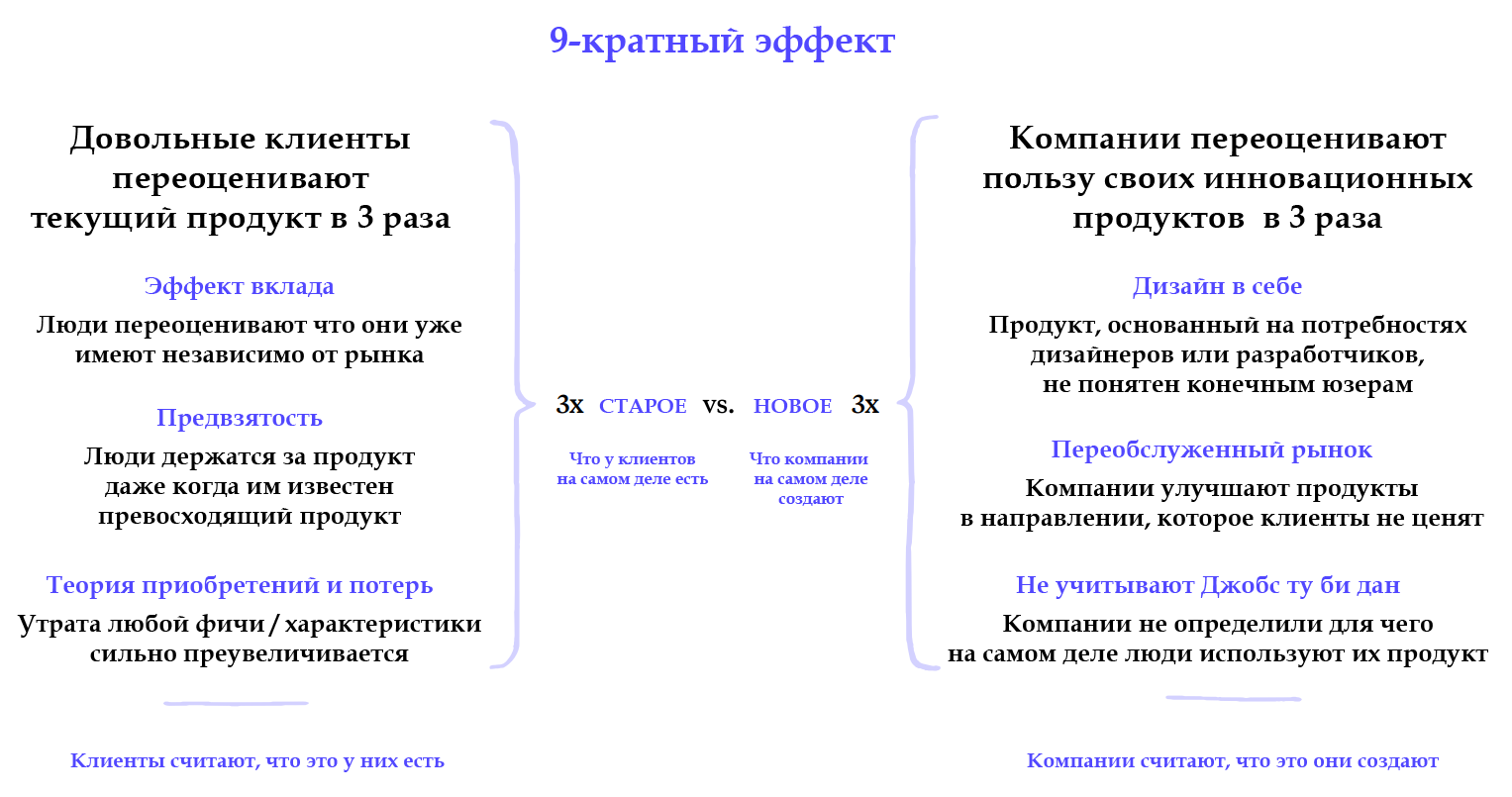
To understand why the inertia is so great, just look at the comparison that customers make when switching.
The mismatch shows why a new product that is marginally better than an existing solution rarely succeeds. Hence the conclusion: any new product must be 10 times better to be chosen by the majority. Only in this case will the switch become self-evident. All developers dream about it.
To take possession of a customer, consider all four forces when promoting a product. It happens that your product is more than good, but one of the forces interferes with you. Include this in your ad and you'll notice improvements.
Understand that customers are overestimating the current solution, just as you are overestimating the quality of your product. This means that a product with minor improvements will not take off. Only the “Tenfold product” will become the leader.
Chapter 5. Where the work ends and the next one begins
Posted by: Des Traynor
Software companies are constantly faced with the question: “Should I add another feature?” The standard answer is yes. If you are good at creating software, then you want to solve all the problems in the world with the help of programs.
At Intercom, we have learned to understand where our product ends. Following Jobs-to-be-Done quite strictly, you can try to close the entire working day of the client using your product. You could start by developing a time tracker, then add the billing function, then the ability to fill out closing documents. And while you are aware of this, you have already created the perfect solution for a very small group of users. Therefore, understanding where your product ends is very important.
***
The most important task of a product manager is to determine when his product will end and the client will take on another product.
If your product has too little functionality, then you should not spend money on its installation, even without considering its cost. Also, if the product performs too many operations, it will be faced with an existing software or workflow that satisfies users. This is a Goldilocks problem - you need a product that is just right.
Understanding your product’s workflow
Take for example the time tracker. At the absolute minimum, this is simply the sum in the column with numbers. If this is all the functionality of your software, then it is absolutely useless. Excel or Google Sheets already do the job. Simplicity in this case does not make sense. Even ingenious design will not help such a product work out the cost of maintenance.
At maximum, the time tracker may include project management, budgeting, contractor management, billing, document management, and employee monitoring. Such an application solves many related problems, due to which it steps on the heels of already used products. In this case, it is Xero, Wrike, Basecamp, Teamwork, etc.
The product must solve problems throughout the entire workflow. He has points of beginning and end. To understand where these points should be, it is necessary to represent the workflow as a whole. Let's look at the example of a team ordering lunch daily.

If you are creating an application with which the team can order lunch daily, the workflow should look like this:
- Someone is hungry.
- He or she reports this to the rest.
- The discussion begins - somewhere to go or arrange delivery.
- The following discusses where to order food.
- Menus of different restaurants are transferred from employee to employee.
- A decision is made.
- One person is assigned to collect all dishes.
- He places an order.
- Specifies the delivery time and cost.
- Time passes.
- Food arrives and is eaten.
- The total amount of the order is calculated and a colleague who has not paid is searched.
- Money is collected today or collection is postponed until tomorrow.
- Someone writes about food on Twitter or Facebook, and someone posts food on Instagram. The rest will write a review on Yelp.
- Everyone is back to work.
When you understand the whole workflow, you can focus on the most pronounced, painful area where your product can help, or on a fragment that can be made more fun or interesting with the product. Ask yourself: “Is my product a vitamin or painkiller ?”
Where do you start?
Your product should start from the first step, which adds value. In our lunch example, this is probably the fourth step. An earlier start will result in something like a chat or e-mail. The idea is doubtful.
We give a real example. Instacart is a food delivery service from stores. The creators tried to repeat the entire supply chain of grocery stores: the purchase of warehouses, trucks, etc. But they did not add value to it. The first point where they could add value was to place an online order from grocery stores - something that big retailers traditionally struggle with. Understanding the entire workflow and the point where Instacart could add value, they created a great solution.
And they did it using the current infrastructure of food stores, instead of creating the whole chain from scratch.
Other products also do this well. So, Instagram begins with importing your social connections, a time tracker - with importing projects from Basecamp. Good APIs and imports help users get started easily.
Where do you finish?
Budget, time or money should limit, but never describe the boundaries of your product. A large budget should determine how well the problem will be solved, but not the range of problems to solve. An attempt to cover the entire workflow from start to finish and all types of users is close to impossible.
Your product should stop when:
- market leaders (for example, Apple, Netflix, Expedia) are already monitoring your product, and you were not going to stop;
- created many ways to use your product with a large number of user types (calculating salaries in a time tracker will be a difficult feature);
- involved different from the original end users (managers, accountants, etc.);
- it has grown in a direction where it gives no value.
Identify and destroy useless steps

If the user has finished working with your application, and his next step will be to download a file that can be sent via e-mail, then this is a meaningless action. If this is done to export the user's expenses to a CSV file, to download and re-save in XML, and then send it to the accountant, this is also a meaningless action. If the completion of the project means downloading a lot of files, archiving them and sending them to the client for safe storage, this action is also meaningless. E-mail is almost always a source of meaningless actions and rarely carries enough information (“someone left a comment”) or cannot be associated with understandable actions - “confirm” or “mark as completed”.
If your user clicks on a series of steps without analyzing or making decisions, this should be removed.
Future iterations
Always plug gaps before expanding the product. Reliable and finished products benefit from the transition from the boxed version to SaaS, rather than the buggy and bloated ones. Expanding a product to solve a big problem may be great, but it must be done on a solid foundation. If your main product is not complete, then adding new features will only make it worse.
Much has been written about the desire for simplicity, but not so simple: making the product simple is fundamentally different from creating a simple product.
Giving simplicity means removing inappropriate difficulties, so that the user can solve problems as efficiently as possible. At the same time, the creation of a simple product means reducing its boundaries and choosing the minimum segment in the work process in which the product can be valuable. This approach of the smallest possible product creates the risk of becoming a highly specialized solution, or, worse, a feature, but not a product.
When aiming for a “simple product,” know where to draw the line.
Chapter 6. A bad product can do a good job
Posted by: Des Traynor
Most products are obsessed with the complexity of their subject. For example, weather applications focus on rainfall, wind strength, and all types of forecasts that are of little interest to anyone. Typically, users want answers to simple questions: “Will it rain?” Or “How warm will it be?”
We at Intercom paid in blood for this lesson. The cards launched by us have become incredibly popular. We could not understand why this was so, but we were happy to see the involvement of users. In fact, it turned out that people used the feature for a very specific work. It was amazing, since we did not create a map for this.
Paradoxically, we made a bad map, which became a good feature. And we understood a lot.
***
Customers will constantly surprise you with the creative approach to using your product, and they will do it unknowingly - simply adapting your product to their needs.
Remember Peter Drucker's earlier statement about customers who rarely buy what the company sells? Thus, in order to improve a product, you first need to understand how it is used.
Let us explain with an example.
Almost immediately after launching Intercom, we added a map so that users can see where their customers are.
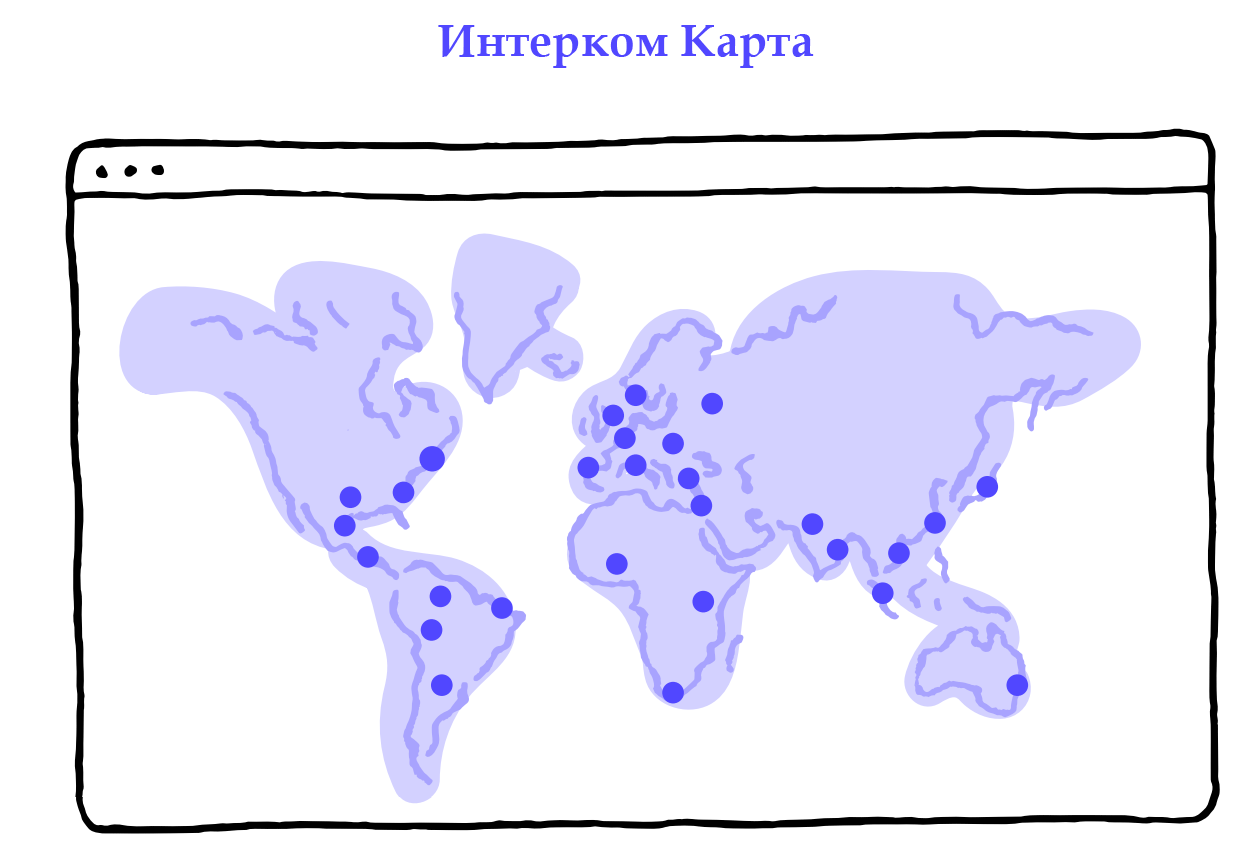
It was a classic “it's cool, but we don’t know why” feature. Traffic demonstrated rapidly growing popularity, but it was difficult to promote the map as a feature, since there were difficulties with understanding, and for what, in fact, it is needed.
There were suggestions that it can be used to:
- Understand where more customers are located, but many product managers already owned this information.
- see the number of customers in a certain city, but the list of users is much better for this;
- see the number of users in the selected country, but here the list was more convenient.
So what are the advantages of the card in addition to its impressive appearance? We list three areas for which it was used.
- For demonstration at exhibitions and conferences.
- To post to Twitter.
- For presentation to investors.

Usage Improvements
We planned to improve the map before we learned how to use it. We were going to focus on:
- geographical accuracy;
- clustering;
- improving the borders of countries and cities;
- other map improvements
All of these “improvements” could take months of development, but it could also end with a deterioration of the product, because the client was not buying what we were selling. It was not a map, but an exhibit.
What could we do to make the card suitable for the present work?
- First of all, give it a greater appeal.
- Provide automatic hiding of unwanted information so that you can safely share it.
- Make sharing convenient.
So we created a beautiful animated map with a unique url that is easy to share.
Bad card does a good job
Fully focusing on how the feature is used, ignoring the topic to which it belongs, or the type of feature, you quickly understand how it can be improved. Instead of trying to turn to the hypothetical markets of potential customers, you can file improvements that will work immediately.
All Articles